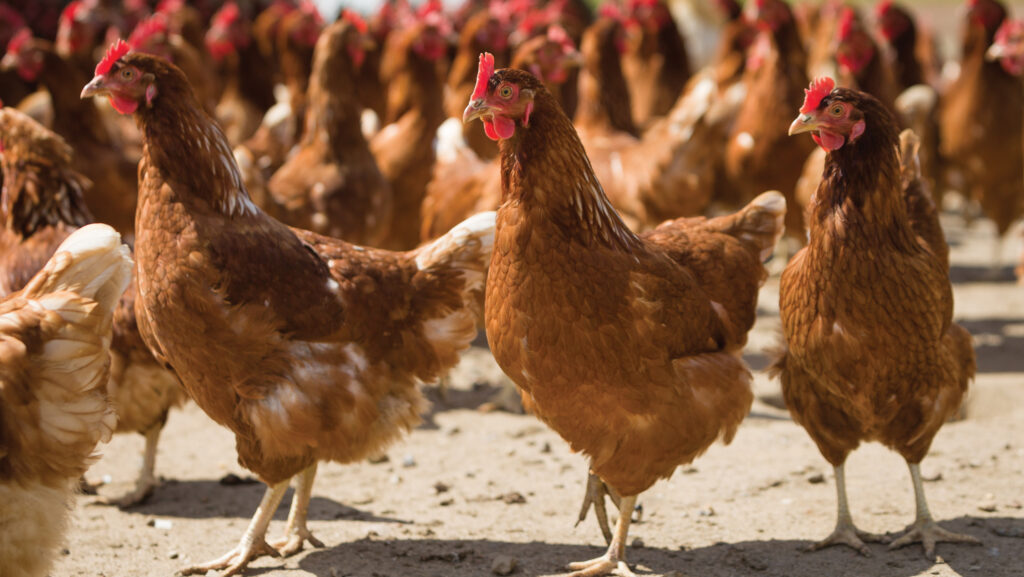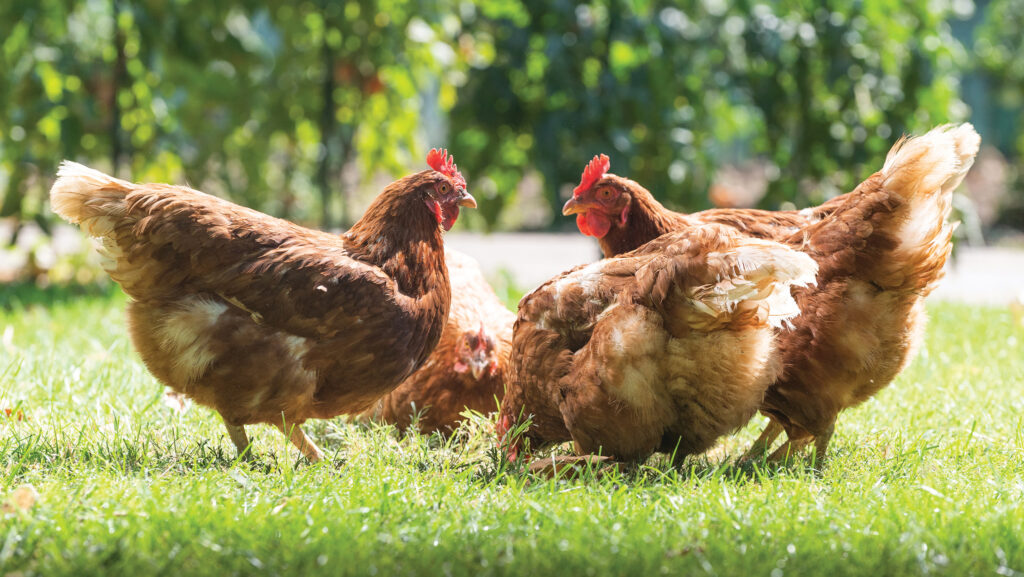Coping with hot spells in free-range layer flocks
 © Adobe Stock
© Adobe Stock Hot weather can be a concerning time for egg producers, with higher temperatures suppressing appetites and inducing heat stress in birds.
When it is hot and sunny, many free-range birds choose not to go out, as they select the environment where they feel most comfortable.
This is according to John Widdowson, technical consultant for Hy-Line UK, who adds: “They don’t like bright sunshine, but where there is a lot of overhead shade on the range, that will encourage birds out, which is obviously a positive from a welfare point of view.”
See also: How to take free-range layers to 100 weeks
He notes that many farms will have good overhead shade, as it is something that has been encouraged by assurance schemes in recent years.
Bird behaviour
Sean Wisdom, a vet at St Davids Poultry Team, agrees. He says behaviour is the best indicator of the bird’s internal temperature.
How a bird feels is influenced by the absolute or dry bulb temperature, the humidity level, and the impact of airspeed, which induces wind chill effects. If these factors combine to push birds out of their thermoneutral zone, behavioural change will follow.
“Birds will start to do things a little bit differently to keep themselves cooler,” says Sean.
Early signs will be that birds will space themselves out in the poultry house and start to hold their wings away from their bodies to increase airflow around them.
If heat stress intensifies, he says open-mouth breathing and panting symptoms will be seen in the flock as they try to lose more heat.
“When the bird is panting, evaporation is happening off the throat and windpipe of the bird,” he explains.
While panting has a cooling effect on the birds, the loss of moisture can put the flock at risk of dehydration, he adds.

© Adobe Stock
Water management
Encouraging water intake will help reduce body temperatures and keep birds hydrated.
John recommends flushing drinker lines to introduce cooler water and improve palatability, which he says is an easy measure for producers to follow.
Sean suggests adding electrolytes to encourage water intake and replace lost nutrients, such as sodium and potassium.
He maintains that rehydration needs to be a priority if the flock is heat stressed, but warns that liquid supplements, such as electrolytes, need to be used at an appropriate time before a period of hot weather.
“I would be very cautious about starting too early,” he says. “If a producer is giving electrolytes when it is not hot, birds may overdrink, and you may start to get more water coming out in the droppings.”
Furthermore, dampening the house can raise the humidity and may counteract the well-intentioned steps taken to reduce heat stress, he argues.
Egg quality
John says it is rare to actually lose layers to heat stress, but production will be affected, including the quality of eggs.
“You tend to get a thinner albumen in hot weather, known as ‘watery whites’,” he says.
This can be more pronounced in older hens, as internal egg quality deteriorates naturally with age.
Older birds ranging in bright sunlight with a lack of feather cover run the risk of paler shells too, he adds.
In addition, panting alters the pH of birds’ blood, making it harder for them to absorb calcium from their diet, says Sean.
This directly increases the likelihood of thinner and paler shells.
Feed consumption
Ensuring birds get the correct nutrients is a key management consideration.
Hot weather is likely to have an impact on feed consumption, with birds that are too warm reducing their intake to limit the heat generated by digestion.
“You’ll get increased drinking behaviour and decreased feed intake,” says Sean. “If feed intake decreases, then either egg production must suffer, or the bird must draw on its body reserves to maintain [egg] numbers.”
He adds that if producers are looking to extend their laying cycle past the traditional 72 weeks, it is important that a flock’s chances of achieving this are maximised.
“The new goal on the horizon is 100 weeks of production. You don’t want to be using up body reserves if you don’t have to,” he says.
According to John, egg weight is likely to be the production factor worst affected.
The effects of heat stress are likely to be most pronounced at peak production when feed intake and egg numbers are at their highest, and intake could drop below 100g/day, he says.
At the same time, a farm rearing pullets may find that hot weather reduces bodyweight gains, which could lead to birds arriving on laying farms below target, with potential implications for future performance, he adds.
Ration changes
Producers can work with their nutritionist to reduce the impact of low feed intake through extended warm periods.
Sean says changing the energy sources within a ration and adjusting the vitamin C level can allow birds to maintain their intake of nutrients even if the volume of feed decreases.
He recommends discussing this with nutritionists well in advance to assess the practicalities.
In addition, birds need to have been on altered rations for a period of weeks before hot weather arrives for it to have the desired effect.
John agrees, but points out that it can be a challenge carrying this out in practice.
“Predicting hot weather can be difficult. We don’t get enough periods of sustained hot weather to invest heavily in mitigating it,” he says.
There is often not enough notice to make alterations to feed rations. And if feed stocks are already on farm to provide a buffer, this can prevent quick changes being made.
Bird management
Creating a cooler environment for the birds can be achieved by alterations to the ventilation system, particularly by adjusting the temperature set point to a lower temperature.
“If you cool the sheds at night, you are starting from a lower point in the morning and have a bit of a head start,” says John.
Extra circulation fans can be brought into a shed to improve air speed and increase the cooling effect on birds.
“Don’t disturb the birds in the hottest part of the day,” he advises. “Do your walk round the birds early in the morning; don’t do it in the middle of the day when it is really hot because you’ll force them to expend energy they don’t need to.”
John says producers should avoid running feeders in the middle of the day, even if they are concerned about feed intake.
“That seems a bit counterintuitive, but it’s best that those birds are just left alone without disturbance in the heat of the day,” he explains.
Hot weather must also be considered when planning transport movements.
“The rearers and the old hen processors are very good at taking this into account, but bird numbers in drawers ought to be adjusted down, and avoid moving birds in the middle of the day,” he says.
